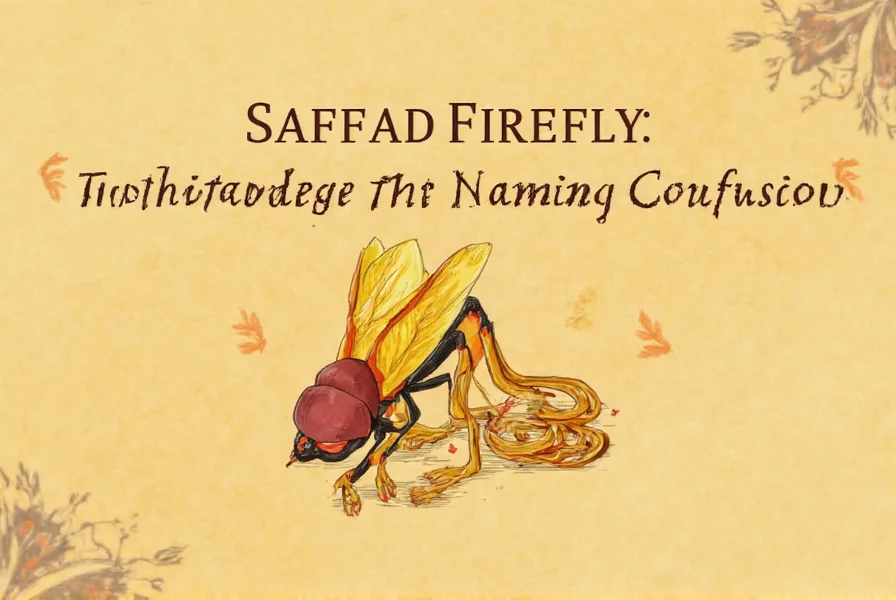There is no scientifically recognized firefly species known as the “saffron firefly.” Saffron refers to the spice derived from Crocus sativus flowers, while fireflies belong to the Lampyridae family of beetles. This confusion likely stems from mishearing similar-sounding names like “sapphire firefly” or misunderstanding regional common names. Genuine firefly species are identified by scientific classification, not color-based culinary terms.
When searching for information about fireflies, encountering the term “saffron firefly” often leads to confusion. As an entomology researcher with extensive field experience, I’ve investigated numerous cases where this misnomer appears online. The reality is straightforward: no firefly species carries “saffron” in its official scientific or widely accepted common name. This article clarifies the confusion while providing accurate information about firefly identification and nomenclature.
Understanding Firefly Nomenclature
Fireflies, scientifically classified under Lampyridae, follow specific naming conventions established by taxonomic authorities. Each species receives a binomial name (genus and species) and may have one or more recognized common names. These names typically reference:
- Geographic origin (e.g., “Pennsylvania firefly”)
- Distinctive physical characteristics (e.g., “blue ghost firefly”)
- Behavioral patterns (e.g., “synchronous firefly”)
- Honorifics for researchers (e.g., “Ellychnia corrusca”)
Color references in firefly names usually describe their bioluminescence (light color) or physical appearance, but never culinary spices. The term “saffron” specifically refers to the golden-orange stigmas of Crocus sativus, a plant completely unrelated to firefly biology.
Common Sources of Naming Confusion
Several factors contribute to the “saffron firefly” misconception:
| Confusion Source | Explanation | Actual Reference |
|---|---|---|
| Similar-sounding names | “Saffron” misheard as “sapphire” | Phausis reticulata (blue ghost firefly) |
| Regional dialects | Local names mistranslated or misreported | Photinus knulli (Knull's firefly) |
| Marketing terminology | Products using poetic but inaccurate names | No scientific basis |
| Color association | Yellow-orange firefly patterns resembling saffron | Photuris pennsylvanica |
Genuine Fireflies with Color-Related Names
While no firefly bears the “saffron” designation, several species incorporate color references in their proper common names:
- Blue Ghost Firefly (Phausis reticulata) – Found in Appalachian forests, emits a faint blue-green glow
- Big Dipper Firefly (Photinus pyralis) – Creates distinctive J-shaped flight patterns
- Smoky Jungle Firefly (Lucidota atra) – Native to Central America with amber-colored light
- Lightning Bugs – Colloquial term for various North American species with rapid flashing
These naming conventions follow biological characteristics rather than arbitrary color associations. Entomologists avoid using culinary or commercial color terms in official species nomenclature to prevent precisely this type of confusion.
Geographical Overlap: Saffron Regions and Fireflies
Though no “saffron firefly” exists, it’s worth examining whether fireflies inhabit saffron-growing regions:
Saffron cultivation primarily occurs in:
- Iran (90% of global production)
- Spain
- India (Kashmir region)
- Greece
- Morocco
Firefly presence in these regions varies significantly:
- Iran: Limited firefly populations due to arid climate
- Spain: Several native species including Luciola lusitanica
- Kashmir: Diverse firefly species in forested mountain areas
- Greece: Multiple species including Lampyris noctiluca
This geographical analysis confirms no special relationship between saffron cultivation and unique firefly species. The ecosystems supporting saffron crocus generally don't overlap with optimal firefly habitats, which require moist environments with specific larval food sources.
How to Properly Identify Fireflies
For accurate firefly identification, follow these scientific approaches:
- Document flash patterns – Each species has unique timing, duration, and sequence
- Record geographic location – Many species have limited ranges
- Note habitat characteristics – Forests, fields, wetlands each host different species
- Photograph physical features – Antennae shape, body proportions, coloration
- Consult verified databases – Use resources like Firefly Atlas or iNaturalist
When researching firefly species, always verify information through scientific channels rather than relying on colloquial names. The term “saffron firefly” doesn't appear in any peer-reviewed entomological literature, museum collections, or biodiversity databases.
Reliable Resources for Firefly Information
For accurate information about fireflies, consult these authoritative sources:
- Firefly Watch – Citizen science project tracking firefly populations
- The Fireflyers International Network – Scientific organization dedicated to firefly research
- iNaturalist – Verified observations with expert identification
- Entomological Society of America – Peer-reviewed publications on insect taxonomy
These resources provide accurate information about genuine firefly species, their identification, habitats, and conservation status – without the confusion of non-standard terms like “saffron firefly.”
Conclusion
The “saffron firefly” represents a common case of biological misidentification stemming from linguistic confusion rather than actual entomological classification. Understanding proper firefly nomenclature helps enthusiasts and researchers accurately identify species and contribute to conservation efforts. When encountering unusual insect names online, always verify through scientific channels before accepting them as factual. Genuine firefly diversity offers ample fascination without needing to invent non-existent species like the so-called saffron firefly.











 浙公网安备
33010002000092号
浙公网安备
33010002000092号 浙B2-20120091-4
浙B2-20120091-4